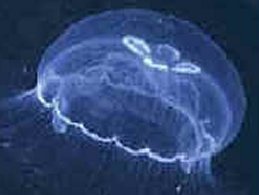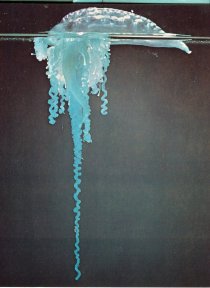
Jellyfish and are among the most beautiful and stunning animals of the sea.
Jellyfish are not only found in New Zealand but all around the world and in every ocean. Apparently there are even some jellyfish that live in fresh water lakes and rivers.
Jellyfish can look pretty weird because they come in strange shapes and colors. They can be shaped like a bell or an inverted bowl.
They can grow from 3mm to 2 meters or 1/8" to just over 6" in diameter. However most around our coasts would be the size of a saucer or smaller. One large jellyfish found in the artic can grow up to just under 2 metres long and it's tentacles can be up to 35 metres or 120 feet long.
Although a few types are a danger to people, most are harmless.
Jellyfish are fish eating animals that float in the sea, they lack bone and thick muscles.
Although most jellyfish are capable of some type of movement, their long distance travels are generally under the control of currents and other patterns of water movement.
Jellyfish usually just drift around in the seas currents, but occasionally you will see them swimming. One disadvantage is that they may be carried into areas that present multiple dangers such as being beached or thrown onto rocks.
Jellyfish swim by rhythmic pulsations of the body. This movement is very like an umbrella being open and shut slowly. It is coordinated by a very simple nervous system and by sense organs around the edge that are sensitive to light and gravity and chemicals in the water.
Take a jellyfish out of water and it collapses into a blob. This is because they are exceedingly delicate and easily damaged, with a gelatin-like consistency, because it's body is composed of 95% or more water, this means that a jellyfish requires the support provided by the water.
Most jellyfish are often clear or a pale bluish in color. However some jellyfish bodys may be a color such as pale blue, orange, brown, white, pink, yellow, deep blue, bright purple, or even red.
These marine animals are remarkable in their abilities to swim and capture food without the aid of hard skeletal parts.
They usually wait for small fish to swim or drift into their tentacles. They then catch their prey by using nematocysts (small stinging organs), present in the tentacles. Some of these stinging tentacles are like miniature harpoons with barbs on the end that inject poison to paralyze their prey. Some Jellyfish have sticky harpoons and others wrap their harpoons around their prey to trap it.
Some jellyfish glow in the dark (this is called phosphorescence).
One property of the gelatinous tissue of the jellyfish is that it is often transparent to light.
The venomous sting of some jellyfish can really hurt, a common one found in the waters around New Zealand would be the Portugese man-a-war (below), otherwise more commonly known as the blue bottle. You normally see these washed up on the beaches around the country they are about 50 mm or 2 inches long and are blue to transparent colour.

The sting of some jellyfish have been known to kill some people.
Jellyfish have no intestines, and the small amounts of waste that they do produce are passed out through their large mouth. If they carried large amounts of food it would be difficult to stay afloat.
Jellyfish have no lungs, gills or any special breathing organs. The walls of the body and tentacles are so thin that the oxygen molecules are able to pass directly from the water into the internal organs and the carbon dioxide molecules pass out of the body in the same way.
Individual Jellyfish are either male or female. The eggs and sperm develop in special areas inside the body wall. When all of the eggs and sperm are fully developed, they are released into the stomach and then through the mouth into the sea. These become very tiny creatures called Planula.
The Planula is able to swim and may be carried a considerable distance by ocean currents lasting from a few hours to several days. The tiny Planula then makes its way toward the sea bottom where it actively looks for a suitable place to attach itself. This plantula immediately begins to grow into a Polyp. The Polyp may continue to live for several years.
Each Polyp begins a different sort of reproduction. At this time a series of grooves appear in the body of the Polyp, which become deeper and deeper as time goes on. Finally, the grooves become so deep, that they cut all the way though the Polyp body. In this way, a pile of disc-shaped individual baby Jellyfish can now break off from the stack and swim away to begin it's own life.
Jellyfish don't have many enemies, but there are some fish and snails that nibble on their tentacles because they are immune to their stinging cells. And some sea creatures like turtles will eat them.
Many animals eat jellyfish, including sea turtles and the sun fish.